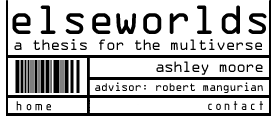

| statement | introduction | site | program | methodology | precedents | development | |
|
precedents for thesis research/work: Project(Location)Atlantic Steel Factory (Atlanta, Georgia) This is a 138-acre site in downtown Atlanta, Georgia which contains a steel factory that has been mostly abandoned by the industry. Its northern and southern borders are edged by neighborhoods of single family bungalows, which were originally constructed as a factory town. The eastern side is bounded by Interstate Connector 75/85; the western side is bounded by heavy rail, a water reservoir and light manufacturing. The proposition is the construction of 5 million square feet of office space, 1.2 million square feet of retail space, and 2,400 housing units on the brownfield site. Belmont High School(Los Angeles, California) Extremely expensive, confusing, and blighted site. This site has had almost every unfavorable fate befall it. This thesis will watch the progression of city's uncertainty of how to reconcile the issues of the site's danger, its extraordinary expense, the need for the space, and the demands of the citizens. The Brewery(Los Angeles, California) (fig. 5) The Brewery is a highly successful redevelopment of a manufacturing site into live-work spaces; a former beer factory and powerhouse have been adapted for use by 'artists and architects'. Many of the tenants move in for the bohemian lifestyle, yet they complain about the noise from the adjacent train yards. This project can be investigated for the dichotomy of upgrading a facility to make it comfortable while downgrading it to an 'authentic' aesthetic. The Canton Mill Lofts(Canton, Georgia) (figs. 6a,b) The transformation of a 1924 textile mill - which once fabricated denim from raw cotton - into 'flats', 'lofts', and 'apartments' to serve the Metropolitan Atlanta Area. Included among the swimming pool, clubhouse, and gym, is the museum-like lobby, which displays artifacts highlighting the history of the mill. Cremaster Film Series(Matthew Barney) (fig. 7) This film series features a variety of items, sets, and props which, at first glance, are confusing; they are beautiful objects, but there is some uncertainty as to their use. This thesis looks at these objects with regards to the idea of the anonymous 'box' in which an occupant could be surrounded by objects which do not fit the PROGRAM but are nonetheless essential to possible future PROGRAMS. I-10, I-110, Hwy.110 Interchange(Los Angeles, California) (figs. 8a,b) This interchange offers a plethora of fragmented and marginalized sites. There is a variety of conditions: fragments between the freeway and the surface streets, fragments between the freeway and the on/offramps, fragments between the freeways themselves, and fragments between the raised freeway overpasses and the earth. The spatial conditions which are available could possibly meet the format of a multitude of PROGRAMMATIC requirements. Lakewood Fairgrounds(Atlanta, Georgia) The 'fairgrounds' is a complex of enormous sheds which have undergone a multitude of PROGRAMS. Originally intended to serve county fairs, the sheds housed sheds animals and vegetable farmers. The next occupant was a entertainment complex of thrill rides, such the a wooden roller coaster seen destroyed in the film 'Smokey And The Bandit'. The next PROGRAM inserted into the fairgrounds was a short-lived attempt to create a film industry in the south east of the United States. The 'fairgrounds' are currently used for a monthly antique and flea market, and an amphitheater has been created for the outdoor performance of popular music. Pershing Place(Atlanta, Georgia) This building functioned as an office building for the Federal government until the consolidation of government services in a new building across town. Immediately upon the exit of the government offices, conversion of the building into 'lofts' was begun. Though the facilities were functional and relatively new; the current developer is taking great care to 'expose' the building's material and structure; this is done in an attempt to reconcile the units he or she intends to sell with the image that the public holds of true 'lofts' which exist in buildings with backgrounds in industrial or manufacturing PROGRAMS. Sears Roebuck Building(Atlanta, Georgia) Once upon a time, before the department stores and shopping malls, this was the clearinghouse for the Southeastern United States for the mail-order catalog giant Sears-Roebuck; this enormous building, complete with its own power plant, is currently being converted into the 'City Hall East' for the City of Atlanta. Underground Atlanta(Atlanta, Georgia) When Atlanta ceased to rely on the heavy rail transportation system, the annoying and inconvenient tracks which crossed the streets of the downtown intersections were covered with a layer of infrastructure which literally lifted the streets upon viaducts one story above the ground; the second floors of the buildings in a six-block area became the entrance level. The remnants of the original entrances were abandoned for years, then reclaimed as a commercial and tourist district. This endeavor failed and was abandoned for a number of years, until it was revitalized in the 1989 as another commercial and entertainment area; the current incarnation is a commercial interpretation of a commercial interpretation of a archaic transportation infrastructure. Ricola Europe SA Factory and Storage Building (Mulhouse-Brunstatt, France) : Herzog & de Meuron (figs. 9a,b) The appearance of the Ricola Storage Building appears in sharp contrast to the Convention Hall proposed by Mies, but the relationship of the PROGRAM to the BUILDING remains the same. The architects do not acknowledge any purpose to the surface treatment that has any regard to the temporary, albeit less temporary than a convention, occupation. Convention Hall(Chicago, Illinois): Ludwig von Mies Van Der Rohe (fig. 10) The Convention Hall is the product of the full effort of Mies to create an ultimately versatile space. His answer was the largest 'box' that the technological abilities of his employees could produce. The surface treatment of the hall is rational and reserved, perhaps to minimize interference with all possibilities of the temporary habitation. return to top  thesis content written by and property ashley moore, 2000-2015 thesis content written by and property ashley moore, 2000-2015valid: xhtml css |
|||||||